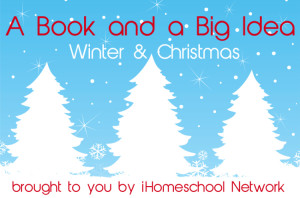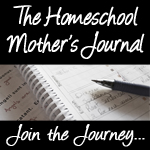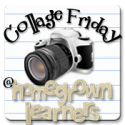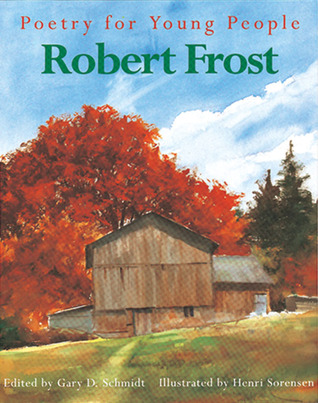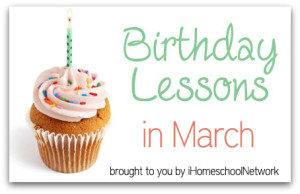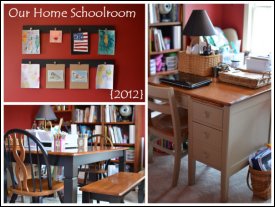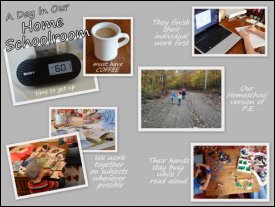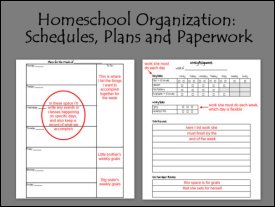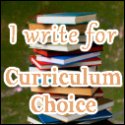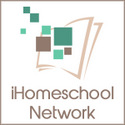 Hi, I'm Heidi and I homeschool my two sweet kids. I want them to know that learning is an exciting lifelong adventure! We love great books, unit studies, notebooking, lapbooking, and hands-on learning.
Hi, I'm Heidi and I homeschool my two sweet kids. I want them to know that learning is an exciting lifelong adventure! We love great books, unit studies, notebooking, lapbooking, and hands-on learning.Christmas Tree Picture Books and Activities
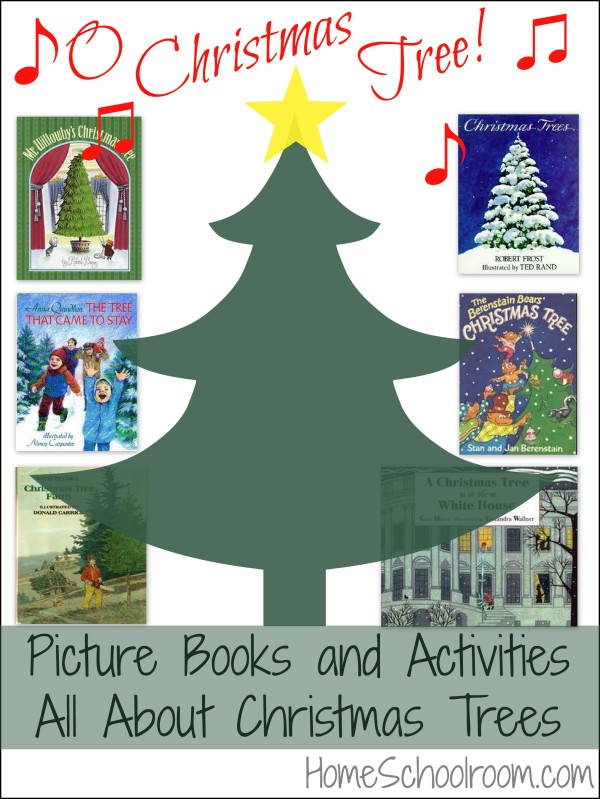
Christmas trees are one of my favorite Christmas decorations. I love sitting in our living room lit only by the twinkling tree lights, reminiscing over Christmases past, recounting the memories in our ornaments, and admiring the pattern of the lights shining through branches onto the ceiling.
We have a collection of beloved Christmas picture books that we revisit like old friends. Just for fun I’m here to share with you our favorite picture books about Christmas trees and activities that pair nicely with the theme–everything from crafts and nature study to poetry and music!
Picture Books About Christmas Trees
Mr. Willowby’s Christmas Tree by Robert Barry: We love this heartwarming story! Wealthy Mr. Willowby has a fine tall tree delivered, but has to cut off the top to fit in his room. The tip of the tree passes down through families (human and animal) to be the center of many celebrations.
Christmas Tree Farm by David Budbill: This is a great living book that tells the story of a man’s work on a Christmas tree farm. Lovely illustrations depict the mountain scenery and the year long job of planting, tending and pruning trees that will grace our living rooms. It’s no longer in print, so check your library or look for another book that tells children about their tree’s life before it came home with you.
The Tree That Came to Stay by Anna Quindlen: This is a sweet story of simple family traditions centered around the tree. I can relate to the sadness of saying goodbye to the tree that shared your Christmas celebrations. In this book they keep a basket of needles from the tree to keep a little part of their tree and the smell of Christmas.
A Christmas Tree in the White House by Gary Hines: This picture book is based on true events during Theodore Roosevelt’s time in the White House. I enjoy stories that let our children learn about past presidents as real people.
The Berenstain Bears’ Christmas Tree by Stan and Jan Berenstain: I am a Berenstain Bears fan, and this story complete with rhyming text doesn’t disappoint. Papa Bear is up to his normal antics as he searches for the perfect Christmas tree, meeting up with misfortunes along the way. As a family that trudges through a tree farm to find our “perfect” tree this story has us laughing, and the tender ending reminds us to think of all God’s creatures during the holiday.
Christmas Trees by Robert Frost and Illustrated by Ted Rand: This poem by Frost was made into a beautifully illustrated picture book. It’s actually alive with the colors of fall on a farm and shows a city man coming to buy Christmas trees from a country farmer. If you know much about Frost you can probably guess that the country life is depicted as preferable.
Christmas Tree Activities
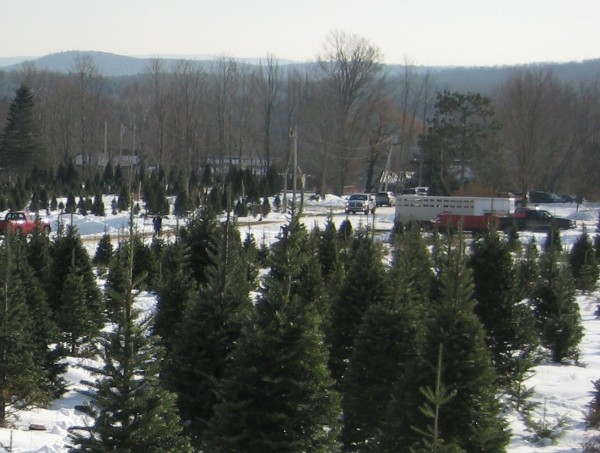
Visit a Christmas Tree farm: If you usually use an artificial tree or buy one from a pre-cut tree lot, try to visit a Christmas tree farm. It’s a treasured tradition in my family to make the trek to the tree farm and wander about the field to choose and cut our own tree. We’ve visited the same tree farm for years. It doesn’t hurt that they offer cider and donuts and a horse-drawn wagon ride!
Make scented sachets from your Christmas tree needles: I love the idea of keeping a little bit of our Christmas tree all year long like in The Tree That Came to Stay. I think we’ll try it this year with scraps of fabric machine or hand sewn into little sachets to tuck into closets and drawers.
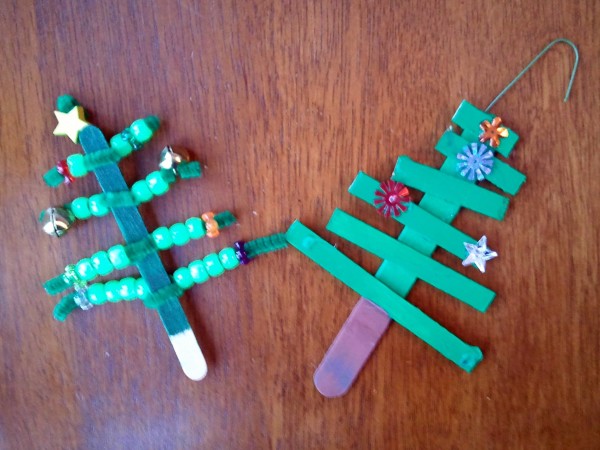
Make an ornament for your tree shaped like…a Christmas Tree! The options are endless so you can find one for any age and crafting ability.
- Pipe Cleaner Christmas Tree: Just paint (or use a marker) to color the craft stick green or brown to make a tree trunk, then wrap green pipe cleaners around your trunk. After that provide an assortment of beads to decorate.
- Craft Stick Christmas Tree: The other tree is also easy and involves gluing craft sticks together to make a tree shape. I recommend using a large craft stick for the trunk and smaller ones for branches. I like using hot glue because it dries quickly, but white glue would be fine if you allow it time to dry. Paint the sticks brown and green and then glue on sequins or buttons or whatever for decorations.
- We’ll be stepping it up this year and sewing this fabric Christmas Tree ornament. I can’t wait to see what mix and match fabrics my kids pick out of our fabric stash!
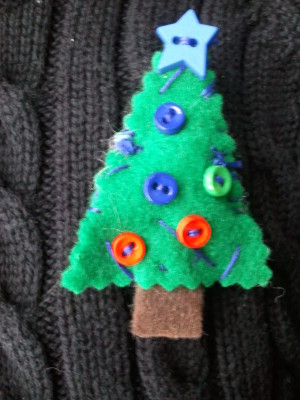
Make a felt Christmas Tree Pin: We started with the idea here, and just added our own touch by decorating it with button ornaments and a star and embroidery floss garland. These were really fun to make, and we just used inexpensive craft felt–though the wool felt would be nice. The photo is one my son made when he was 6. By the way, these make adorable gifts for grandmas or anyone else who would treasure a handmade item from a child they love.
Decorate a tree outside for the birds (and squirrels–we can’t forget Nutty our squirrel friend!): We’ll try some ideas from Wild Birds Unlimited to make some Christmas treats for our feathered and furry friends. On the right hand side of their webpage is a link to download a brochure with recipes.
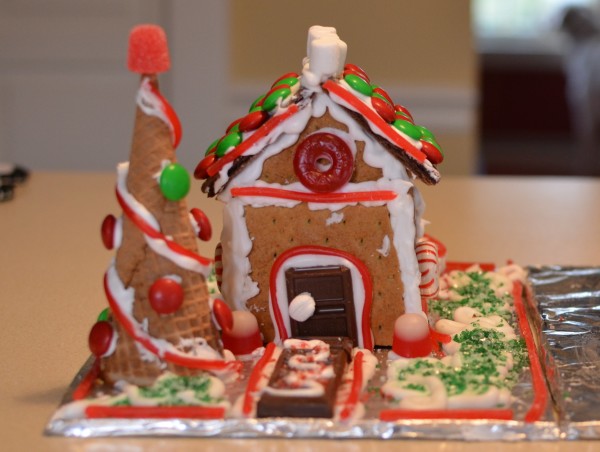
Make edible Christmas trees from sugar cones like these ones from Erica at Confessions of a Homeschooler. I’ve done this with groups of kids at Girl Scouts and kids at my home to add to our gingerbread house decorations.
Incorporate a little nature study: What better time to study trees than when you have a large specimen in the middle of your living room! If you don’t already know the variety you can find out using the Arbor Day website. Here you can see a list of the top ten Christmas tree varieties with links to learn more about them.
Include some music appreciation: How about studying the Christmas Carol “O Christmas Tree” to incorporate a little music? I hadn’t realized how many versions there were until I searched when writing this blog post. You can read a little more about the carol on Wikipedia and listen to whatever version you have in your holiday music at home.
Learn about the history of Christmas Trees: When did people start bringing a tree into their homes and decking it with lights and ornaments? The History Channel offers a lengthy article and many videos discussing the history of the center of our holiday decorating.
If you’re like us and put aside the regular curriculum to savor this special time of year, visit my Pinterest page for more Christmas activities to do with your kids.
You’ll also find more ideas as part of iHomeschool Network’s roundup of winter and Christmas “A Book and a Big Idea” posts!
Iditarod Unit Study
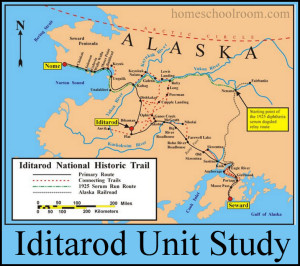
A quick mention on the news late last week piqued our interest about the Iditarod, the famous dog sled race that crosses more than 1000 miles of Alaska in honor of a historic and heroic race for serum to save a town. I compiled a unit study and we worked on it a bit every day this week. I didn’t set aside our regular work, but with something they were so interested in I could use it as a fun way to finish off our days when all the other work was done.
Resources for our Iditarod Unit Study
Books
- Racing the Iditarod Trail by Ruth Crisman was our nonfiction resource book.
- The Bravest Dog Ever, The True Story of Balto by Natalie Standiford
- Togo by Robert J. Blake is a must read along with the Balto book, it gives the account of another dog hero of the famous 1925 serum race–Togo actually traveled 5 times more miles than Balto.
- Akiak, A Tale From The Iditarod by Robert J. Blake is a story of a modern Iditarod race dog.
Videos
- Discovery Channel’s Iditarod: Toughest Race On Earth: This Discovery channel 6-episode show gave us a front-row seat for the race, up close and personal with mushers and their dogs, both on the trail and at checkpoints. (We were able to watch on Netflix.)
Online Resources
- Homeschool Share: I used a few minibooks about Balto from a unit for Five True Dog Stories. For others topics I used blank minibooks from Homeschool Share’s lapbook resources page. I used Google image searches to print photos of Balto and Togo with their mushers.
- Iditarod Official Website: There is a lot of great information here for the current year’s race–musher profiles, race times and winners, and even news stories (like the death of one of the dogs this year). Note: This site raises money through paid “Insider” subscriptions so some content is not free. There are a few videos for classroom use that are free and a free downloadable map of the race trail.
- About.com has free coloring pages, word searches and crossword puzzles.
- Scholastic has a great Iditarod page with pictures and information–much of it from real Iditarod mushers!
A Peak Inside Our Iditarod Lapbooks
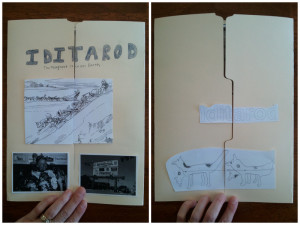
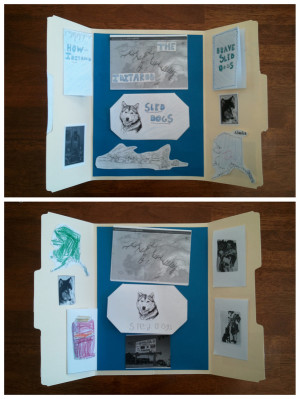
The information in the minibooks:
- The history of the Iditarod, both the 1925 serum run to save the residents of Nome from a diptheria outbreak, and the two sled dog heroes, Togo and Balto.
- The modern Iditarod Race
- All about sled dogs–their training and how they are cared for on the trail.
We enjoyed learning about the Iditarod and look forward to following the race in future years to cheer for our favorite mushers!
Thank you to the wonderful hostesses with fun link-ups on Fridays. Be sure to join the fun and see what other homeschoolers are up to!
Poet Study: Robert Frost
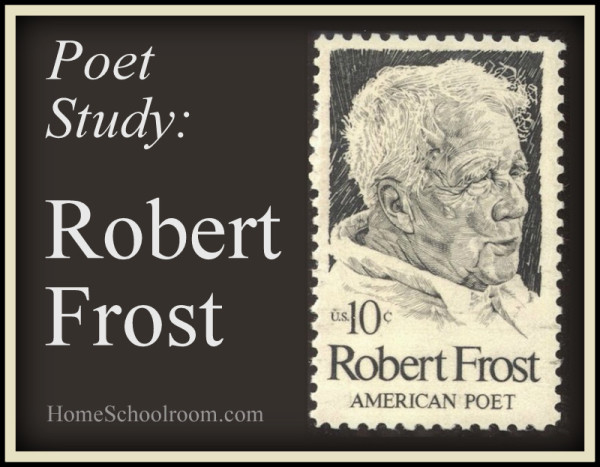
I read poetry to my children regularly. Sometimes I share poems from anthologies and sometimes poems related to the season, holiday, or our studies in nature or history. Other times we focus on one poet, and March is a great month to enjoy a study of Robert Frost, who was born on March 26th, 1874.
Other than the fact that it’s his birthday, and that he’s one of America’s best-loved poets, what homeschooler doesn’t identify with these famous lines:
Two roads diverged in a wood, and I–
I took the one less traveled by,
And that has made all the difference.
~from “The Road Not Taken” by Robert Frost
Getting to Know Robert Frost
Born and raised in Maine, I feel a special connection to his poems depicting scenes of rural New England life. I was amused to find that he was actually born in California! He moved to New England (where his family was from) when he was 11.
Although he was writing poems as a young adult he was not able to support himself as a poet until much later in his life. In the meantime he wrote for newspapers, taught, and farmed (though not very successfully). It wasn’t until he moved to England in his late 30s that his work was accepted by a publisher in Britain. He moved back to America, and ten years after his first book of poetry was published he won the first of four Pulitzer prizes.
Poetry for Young People: Robert Frost has a short biography of the poet. This biography online also has nice information about not just his poetry but also his personal life. I find his life story interesting and worth sharing with my children: there is a lesson to be learned about following your passion even if you aren’t immediately successful.
Getting To Know Robert Frost’s Poems
I can’t recommend the Poetry for Young People series highly enough. With the story of the poet at the beginning, and then a selection of poems with accompanying artwork, it is worth adding to your bookshelf. I also appreciate the notes at the bottom of the page that help explain the theme or style of the poem.
Several of his poems have been made into picture books–a perfect way to introduce his poetry to younger children and enjoyed by all ages in our home:
Here are some free resources for enjoying his poetry:
- There are links to many of his poems on the right sidebar at The Academy of American Poets website.
- Librivox has a free audio download of eight poems.
- You can also watch a video of Frost reading “Stopping By Woods on a Snowy Evening.”
Adding the Extras
Reading about the poet and sharing his poems can stand alone, but you can further the learning (or just the fun) by adding in any of these enrichment ideas.
- Jimmie has perfect Robert Frost Notebooking Pages over at the Notebooking Fairy.
- Use one of his poems for copywork.
- Have your child memorize their favorite Frost poem.
- Print a poem and have your child illustrate it.
- The chalk pastel tutorials Tricia posts at Hodgepodge are one of my favorite art resources! Several would go well with the scenes of nature in many Robert Frost poems: To The Woods, Tree Silhouette, Apple, Old Shed in the Snow.
- According to the Robert Frost Farm website, the Frost family served banana pudding topped with chocolate syrup and whipped cream at birthday parties. I’m always game to add food to our studies!
Hop on over and check out other unit studies of fascinating people born in March from the bloggers of iHomeschool Network!
Unit Study: The Science of Snow
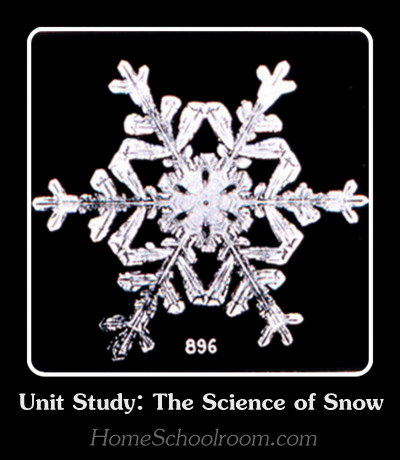
Our local public school was on vacation this week. I don’t usually take those weeks completely off, but they are perfect weeks to drop the regular curriculum and enjoy a fun unit study.
Though some of you may be fortunate enough that late February is the end of winter, in Maine spring is still weeks (months!) away. Great timing for a unit study on snow, focusing on the scientific aspects of snowflakes and crystals. After piquing their interest with the microscopic wonder of snowflakes I wanted to teach them about crystals and answer the question: Is it true that no two snowflakes are alike?
Wow! Snowflakes are miraculous!
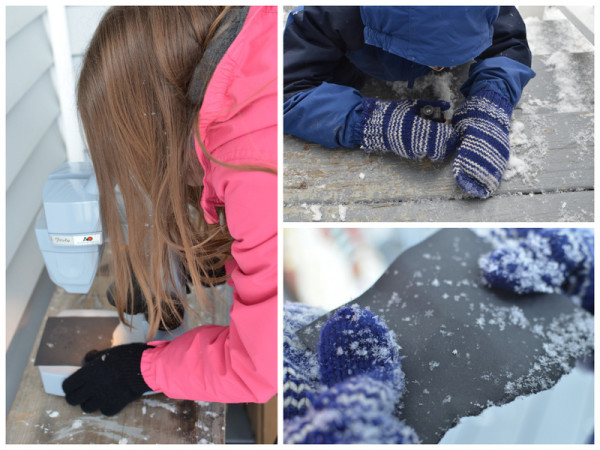
I laid the foundation for their interest a couple weeks ago when I saw large, beautiful flakes falling outside. Grabbing the piece of black paper I’d been keeping in my freezer for just such an occasion, we headed outside with various magnification tools: hand lenses, pocket microscopes, and a stereoscope. I highly recommend this activity whether you go on to study snowflakes or not.
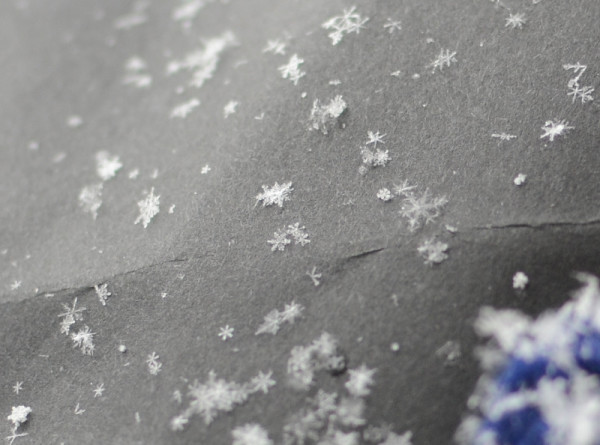
Then this week we kicked off the unit with the picture book Snowflake Bentley about Wilson Bentley, a man who lived in Vermont and spent his life photographing snowflakes to share their beauty with the world.
Homeschool Share offers a free lapbook to go along with this book and is where I found all the minibooks we used. We also perused the thousands of images in Wilson Bentley’s original book, Snow Crystals.
Learning about snowflakes and crystals
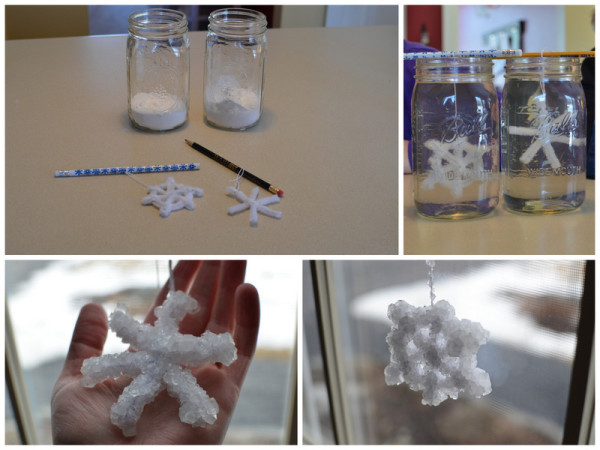
What better way to learn about crystals than to grow them? Making Borax snowflakes gave us the chance to watch crystal formation and drive home the main point: crystals arrange themselves into the patterns dictated by their molecules. While Borax crystals are simple cubes it is the same process that forms the intricate patterns found in each snowflake.
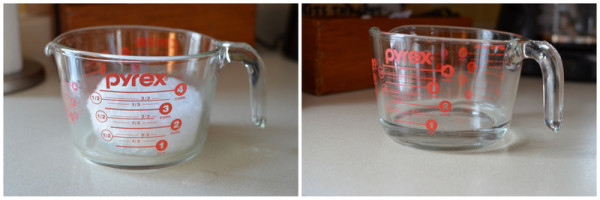
We brought in some snow and made guesses about how much water we would have when it melted. (All of our guesses were too high!) A nice printable from the Homeschool Share unit recorded the information. I used the physical demonstration from Living and Learning at Home to explain the scientific basis for it: we stood near each other with our arms out and realized we couldn’t stand very close to each other. With arms at our side we could pack ourselves in much more closely–just like the water molecules!
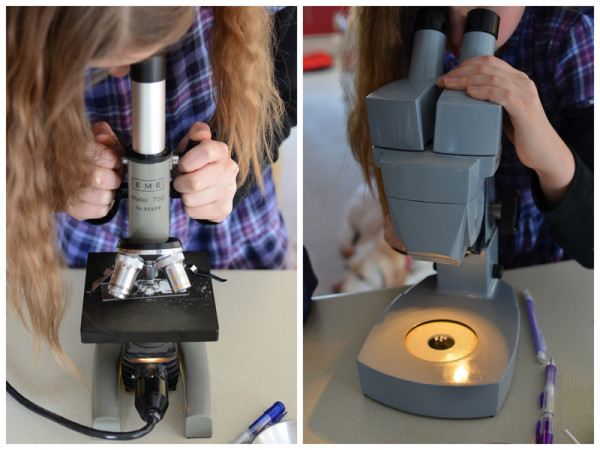
We brought out the microscopes to examine crystals of Borax, salt and sugar. My favorite part about using microscopes is how they increase our wonder at nature: when you see the tiny details you can’t help but be amazed!
Is it true that no two snowflakes are alike?
The book I used to cover the scientific information was The Snowflake: Winter’s Secret Beauty by Kenneth Libbrecht. This book was too advanced to be used as a read aloud, but was perfect for a picture walk. We looked at the images of modern snowflake photography and read the informative captions. This is great video clip about the author:
Once we learned about the factors affecting snow crystal formation, temperature and humidity, it was easy to understand the variety of patterns. As each individual snow crystal moves through different parts of the cloud due to wind and gravity the shapes on the branches tell the history of the conditions it went through. Since no two snowflakes follow exactly the same path to the ground, no two will be truly identical!
The Extras
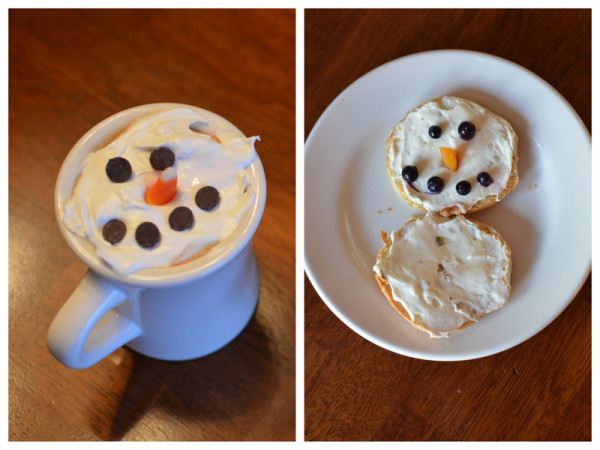
I usually can’t resist a little themed food when we’re studying a topic. Melted snowman cocoa and a snowman bagel fit the bill perfectly. The bagel face is made from blueberries and a piece of dried apricot. (Note: Be sure you have regular cream cheese for the bagel. Don’t be like me and only have chive and onion cream cheese.)
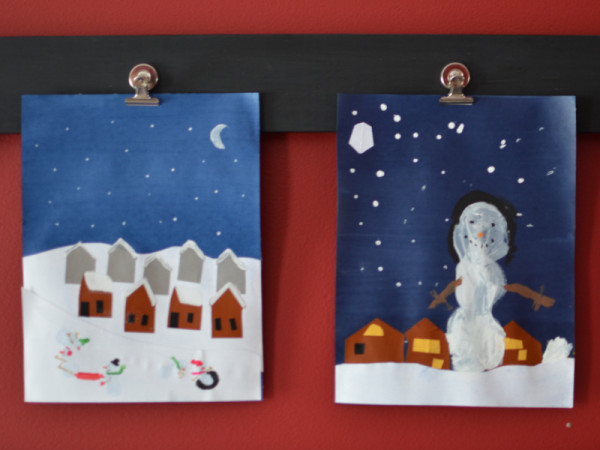
To finish the week we enjoyed a snowman art project from Deep Space Sparkle. She based it on the book Snowmen at Night, a delightful picture book we’ve enjoyed for years.
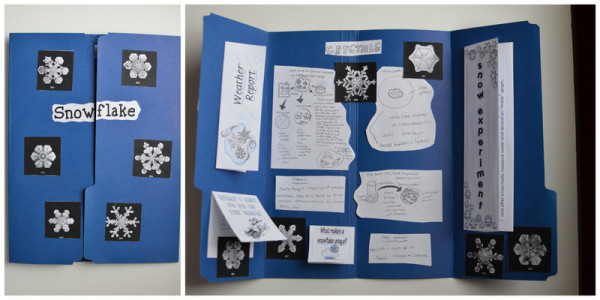
Inside my daughter’s lapbook you can see the minibooks from the Homeschool Share unit and drawings she made when we examined crystals under the microscope.
If you’re still in the throes of winter like me, take a peek at my Winter Activities Pinterest board. You’ll find ideas that are educational, crafty, and just plain fun!
I’m linking up with these great hostesses–join the fun and see what other homeschoolers are doing!
Holiday Homeschooling: Remembering the Reason for the Season
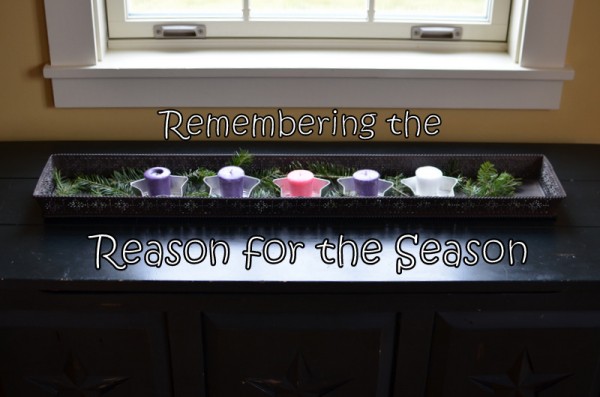
I shared last week how we count down the days until Christmas. This year I added two daily activities to our Advent plans to remind my kids of the real reason for all this celebrating. I wanted a daily reminder to balance out visits with Santa and thoughts of gifts.
Jotham’s Journey
There are three books in this series of advent devotionals by Arnold Ytreeide: Jotham’s Journey, Bartholomew’s Passage, and Tabitha’s Travels. The author describes them as an ADVENTure story that will help your family appreciate the true meaning of Christmas. This is our first year so we’re starting with Jotham’s Journey. You begin daily readings on the fourth Sunday before Christmas, so we began this past Sunday, December 2nd. So far my kids are on the edge of their seats and begged me not to stop after last night’s reading.
We didn’t have our own set of advent candles until this year, and this devotional prompted me that it was about time. It adds special ambiance and symbolism as we read the book by the light of the advent candles.
Jesse Tree
I had read about Jesse Tree devotionals that trace events of the Bible beginning with Creation and leading up to Jesus. Though it was a wonderful idea I didn’t think I would add it in since I’d already purchased supplies and planned for Jotham’s Journey. Then I saw that Ann Voskamp was offering a free download of a Jesse Tree Study with printable ornaments. How could I resist?
She includes the ornaments in color and black and white for coloring yourself. I used the black and white option to trace the designs onto shrink film. (Never heard of shrink film? Remember Shrinky Dinks? Thin plastic sheets that shrink, becoming thicker, after heating.) My kids colored them and I shrunk them so we have a nice, durable set of ornaments we can use year after year.
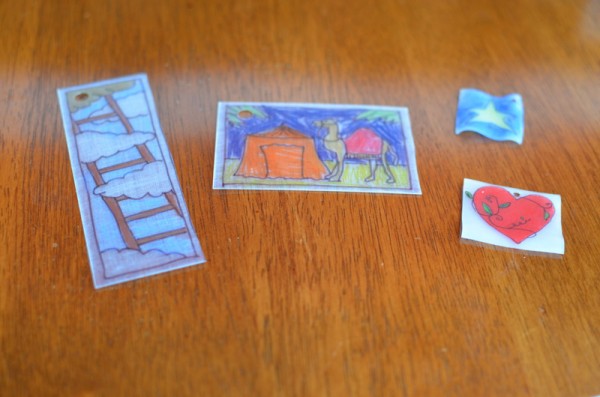
*In the photo the two on the left are full size, the two on the right have been shrunk.*
How do I schedule two devotionals? We do the Jesse Tree reading and hang the ornament in the morning, and in the evening after dinner we read Jotham’s Journey by the light of our Advent candles. I’m so glad we’re doing both because we start and end our days during this wonderful season with a Christmas activity that focuses on Christ.
I hope you’re having a delightful Christmas season, and will come back when I share how we keep learning all month while celebrating!
Capitalizing on the Excitement of a Presidential Election
I’ve mentioned how we watch CNN Student News every morning over breakfast when I wrote about our daily schedule. It is a routine we all enjoy and a great way to introduce my children to current events. They’ve been asking lots of questions since the beginning of the presidential primaries, so I knew this was a great year to do a unit study on U.S. government and elections.
I took the time to put together an elementary-level unit study and lapbook. I am ever grateful for Homeschool Share and the people who put time and effort into making resources that others can use free of charge. I was able to find all the minibooks for our government and elections lapbook from free HSS lapbooks or their blank minibook templates. I compiled a list of books to cover the topics–quality books are always the backbone of our studies. Lastly, I enjoy rounding out our units with educational videos, websites and songs, so I found some fun additions to reinforce concepts.
Are any of you hoping to capitalize on this election-year excitement to teach your kids about our system of government and the election process? If you’d like you can read the details on what we’ll be doing for a government and elections unit.
We’ll work on this lapbook in early October so the information will be fresh in their minds as the campaigns really ramp up before election day. We’ll continue watching Student News each day, watch debates and speeches together, and take field trips to see and candidates that visit locally. It should be an exciting, educational election season!
Maple Syrup Study Finished
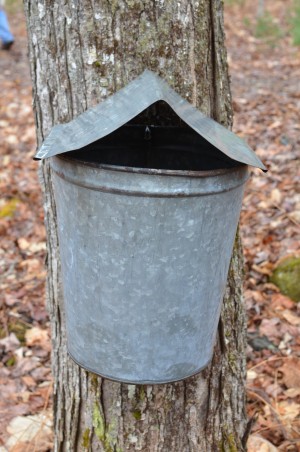
We started a maple syrup unit in March with a field trip to a local farm on Maine Maple Sunday. We worked on this unit for two months, partly because there was a lot involved in the study, and partly because we had a lot of activities and other schoolwork going on. It was an educational (and tasty!) study. You can read all about our Maple Syrup Unit on our Unit Studies page, where you’ll find the resources I used and pictures of our completed lapbooks.
We celebrated finishing this week by making Sugar-on-Snow. We felt a bit like Laura Ingalls (well, other than using crushed ice from our ice maker instead of snow from outside)! We used a recipe from The Maple Syrup Cookbook by Ken Haedrich, except I did a smaller batch of it in the interest of healthy eating and low dental bills. It got a big thumbs-up from my kids. Possibly because their teeth were stuck together so they couldn’t actually say anything.
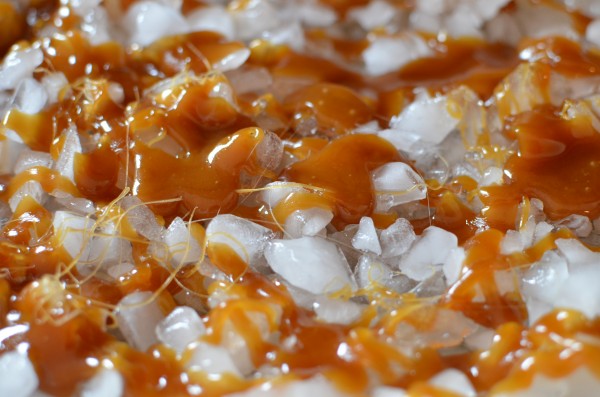
We had been working on this study for so long that we were a little sad to finish it. We enjoyed everything from the field trip to the sugarshack, cooking with maple syrup, and learning all about the science and history of maple tapping. The lapbooks turned out beautifully, and we’ll never pour syrup over our morning pancakes without thinking about all we learned!
